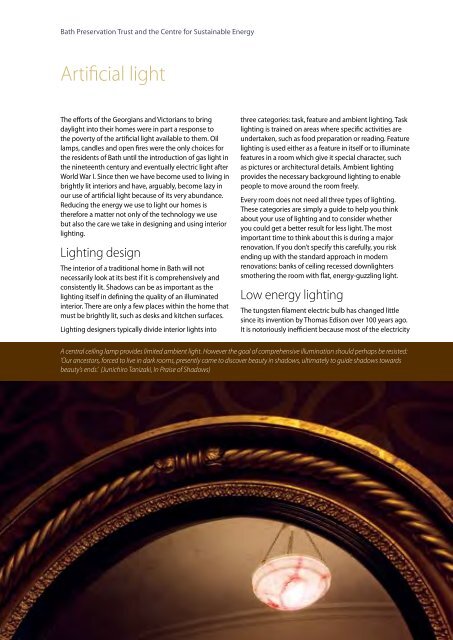Warmer Bath
Create successful ePaper yourself
Turn your PDF publications into a flip-book with our unique Google optimized e-Paper software.
<strong>Bath</strong> Preservation Trust and the Centre for Sustainable Energy<br />
Artificial light<br />
The efforts of the Georgians and Victorians to bring<br />
daylight into their homes were in part a response to<br />
the poverty of the artificial light available to them. Oil<br />
lamps, candles and open fires were the only choices for<br />
the residents of <strong>Bath</strong> until the introduction of gas light in<br />
the nineteenth century and eventually electric light after<br />
World War I. Since then we have become used to living in<br />
brightly lit interiors and have, arguably, become lazy in<br />
our use of artificial light because of its very abundance.<br />
Reducing the energy we use to light our homes is<br />
therefore a matter not only of the technology we use<br />
but also the care we take in designing and using interior<br />
lighting.<br />
Lighting design<br />
The interior of a traditional home in <strong>Bath</strong> will not<br />
necessarily look at its best if it is comprehensively and<br />
consistently lit. Shadows can be as important as the<br />
lighting itself in defining the quality of an illuminated<br />
interior. There are only a few places within the home that<br />
must be brightly lit, such as desks and kitchen surfaces.<br />
Lighting designers typically divide interior lights into<br />
three categories: task, feature and ambient lighting. Task<br />
lighting is trained on areas where specific activities are<br />
undertaken, such as food preparation or reading. Feature<br />
lighting is used either as a feature in itself or to illuminate<br />
features in a room which give it special character, such<br />
as pictures or architectural details. Ambient lighting<br />
provides the necessary background lighting to enable<br />
people to move around the room freely.<br />
Every room does not need all three types of lighting.<br />
These categories are simply a guide to help you think<br />
about your use of lighting and to consider whether<br />
you could get a better result for less light. The most<br />
important time to think about this is during a major<br />
renovation. If you don’t specify this carefully, you risk<br />
ending up with the standard approach in modern<br />
renovations: banks of ceiling recessed downlighters<br />
smothering the room with flat, energy-guzzling light.<br />
Low energy lighting<br />
The tungsten filament electric bulb has changed little<br />
since its invention by Thomas Edison over 100 years ago.<br />
It is notoriously inefficient because most of the electricity<br />
A central ceiling lamp provides limited ambient light. However the goal of comprehensive illumination should perhaps be resisted:<br />
‘Our ancestors, forced to live in dark rooms, presently came to discover beauty in shadows, ultimately to guide shadows towards<br />
beauty’s ends.’ (Junichiro Tanizaki, In Praise of Shadows)<br />
34


